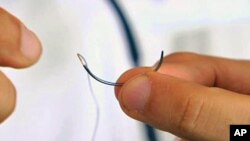A recent study shows that medical students and hospital interns often fail to report self-inflicted needlestick injuries when treating patients. That is a major worry if the patient or the health care worker carries an infectious disease, such as HIV-AIDS or hepatitis.
There is a wide gap between what medical students learn in the classroom and in a medical facility. Real experience has to begin at a teaching hospital, treating patients who are often very sick.
Twenty-four year old Swathi Eluri is a third year medical student at Johns Hopkins University in Baltimore. She is learning on the job at Johns Hopkins Hospital. One minute she is bedside, monitoring a patient's condition. Then scrubbing up before going into surgery.
Eluri and other students must learn to be adept with needles and other sharp instruments. They are supervised.
But a recent study of surgical residents [doctors in training] at 17 medical centers in the United States indicates that almost 60 percent admitted they had sustained needlestick injuries when they were medical students.
To make matters worse, many of these students failed to report the injuries to hospital officials.The lead author of the study done by Johns Hopkins University is Dr. Martin Makary. He says students put themselves and others in danger from infectious diseases when they are stuck. "We put the most vulnerable people on the front lines of this battle," he said.
In surgery, these doctors in training are frequently assigned the task of stitching up the fascia.
"A needle that goes through the skin needs to be as sharp as possible because that's going to be associated with the easiest access, the more slick closure, and the less pain when somebody has, say their blood drawn or their skin closed," Dr. Makary stated.
Dr. Makary is advocating the use of blunt tip needles which are considered safer. "This needle is still sharp enough to penetrate through body tissue," he said. "But it does have a blunt tip, so that if it accidentally goes into my finger, it's much less likely to perforate."
The Johns Hopkins study also recommends that doctors wear two sets of gloves to make them and the patient less vulnerable to infectious diseases.
The study found that 600,000 to 800,000 needlesticks and similar injuries occur each year among health care workers in the United States. While most known cases of HIV or hepatitis are reported, other possible infections often are not.
Swathi Eluri says she has never been injured by a needle. But she knows other medical students who have.
The Johns Hopkins study has urged hospitals to set up a hotline telephone number that medical personnel and students can call when they are injured.
The researchers say a prompt response by the hospital is meant to reassure medical students that there is no stigma in reporting this kind of accident.






